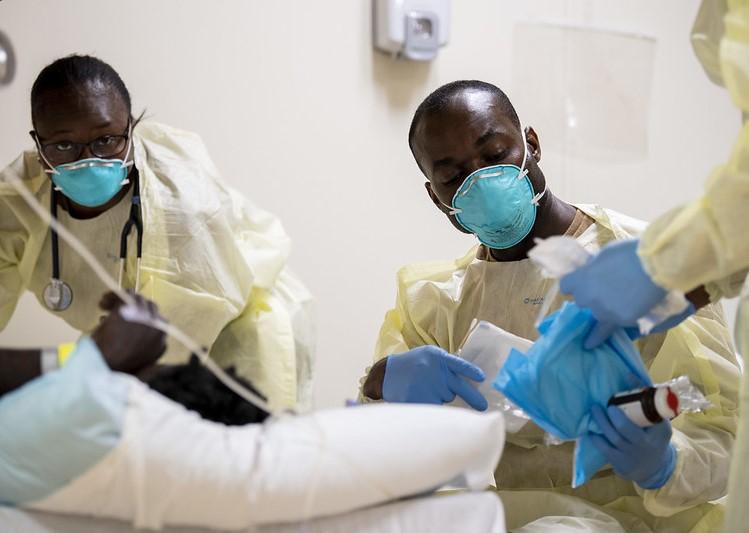- As part of ongoing surveillance for H5N1 avian influenza at fur farms in Finland, officials reported detections at 10 more farms, raising the number of affected facilities since July to 42. In a statement, the Finnish Food Agency said the new detections are in provinces that reported the virus at fur farms in the past and that the newly affected locations mainly raise fox, but a few also have raccoon dogs. In US avian flu developments, two states—Montana and South Dakota—reported more outbreaks in poultry flocks, according to updates from the US Department of Agriculture (USDA) Animal and Plant Health Inspection Service (APHIS). Montana reported the virus in backyard birds in Sweet Grass County and at a commercial farm in Wheatland County. South Dakota reported two more outbreaks at turkey farms in McPherson and Roberts counties.
- The United Kingdom's vaccine advisory group today recommended that governments consider routine vaccination of high-risk groups against mpox and gonorrhea. In a statement, the Joint Committee on Vaccination and Immunization (JCVI) said targeted vaccination against gonorrhea should use the 4CMenB vaccine, given that meningococcal disease (Neisseria meningitidis) and gonorrhea (Neisseria gonorrhoeae) are closely genetically related and that evidence suggests some cross-protection from the MenB vaccine. The experts also said that more regular use of the mpox vaccine in those at highest risk could help prevent major outbreaks. The JCVI said both programs should be offered at sexual health clinics that have experience with assessing and identifying people at increased risk.
- In its weekly update, the Global Polio Eradication Initiative said one country has reported a new polio case, Guinea, which reported another illness involving circulating vaccine-derived poliovirus type 2 (cVDPV2). The infection involves a patient from Kankan province and brings the country's total to eight for the year.
Quick takes: H5N1 avian flu on fur farms, mpox & gonorrhea vaccination, polio in Guinea
WHO updates COVID treatment guidelines, risk estimates for hospitalization

The World Health Organization (WHO) has updated its COVID-19 treatment guidelines, with revised risk categories and hospitalization estimates.
A group of international experts representing the WHO's Guideline Development Group today released its 13th update of these guidelines, which include a new "moderate risk" category for people previously considered to be high risk (ie, older people and those with chronic conditions, disabilities, or comorbidities of chronic disease).
A visual summary of the guidelines in BMJ was updated today.
"The current COVID-19 virus variants tend to cause less severe disease while immunity levels are higher due to vaccination, leading to lower risks of severe illness and death for most patients," the WHO said in a statement. "The updated risk estimates will assist healthcare professionals to identify individuals at high, moderate or low risk of hospital admission, and to tailor treatment according to WHO guidelines."
Lower treatment-benefit threshold
The revised risk categories and hospitalization estimates are:
- High risk: People with weakened immune systems remain at higher risk for severe COVID-19, with an estimated hospitalization rate of 6%.
- Moderate risk: People older than 65 years, those with chronic conditions such as obesity, diabetes, chronic obstructive pulmonary disease, kidney or liver disease, or cancer, and those with disabilities or comorbidities of chronic disease are at moderate risk, with an estimated hospitalization rate of 3%.
- Low risk: People who are not in the high- or moderate-risk categories are at low risk of hospitalization (0.5%). Most people fall into this category.
The WHO lowered its treatment-benefit threshold from a 6% to a 1.5% reduction in the risk of hospitalization. It continues to strongly recommend the antiviral nirmatrelvir-ritonavir (Paxlovid) for people at high or moderate risk of hospitalization. If Paxlovid is unavailable, molnupiravir or remdesivir should be used, but only in high-risk patients.
Antivirals aren't recommended for those at low risk, and the antiparasitic drug ivermectin and the new antiviral VV116 should be used only in clinical trials, the WHO said.
Vaccine exemptions among US kindergarteners increase post-pandemic
The number of kindergarteners with vaccine exemptions increased 0.4 percentage points to 3.0% during the 2022–23 school year compared with the 2019-2020 school year, according to a new study in Morbidity and Mortality Weekly Report.
Exemptions increased in 41 states, and exceeded 5% in 10 states, which increases the risk for outbreaks of vaccine-preventable diseases. The findings come from national- and state-level estimates for complete vaccination with measles, mumps, and rubella vaccine (MMR); diphtheria, tetanus, and acellular pertussis vaccine (DTaP); poliovirus vaccine (polio); and varicella vaccine (VAR); and exemptions from vaccination reported by 49 states and the District of Columbia (DC) for the 2022–23 school year.
Children who started kindergarten this year were first eligible for these vaccines during the height of the pandemic, and researchers have worried gaps in routine care and increased vaccine hesitancy have impacted vaccine coverage.
10 states fail to reach 95% coverage
In the present study, 3.0% of kindergartners had an exemption (0.2% medical and 2.8% non-medical), with a range of less than 0.1% in West Virginia to 12.1% in Idaho, compared with 2.6% reported during the 2021–22 school year.
State-level exemption rates in excess of 5% prevent 10 states from potentially achieving ≥95% MMR coverage even if all nonexempt kindergartners in 2022–23 were vaccinated, up from four states in 2021–22.
"To achieve the Healthy People 2030 target of 95% MMR coverage, exemptions cannot exceed 5%. State-level exemption rates in excess of 5% prevent 10 states from potentially achieving ≥95% MMR coverage even if all nonexempt kindergartners in 2022–23 were vaccinated, up from four states in 2021–22," the authors said.
The authors said it was not clear from the study if parents were opting out of childhood vaccination because of true hesitancy, barriers to standard care, or a combination of the two.
FDA approves first chikungunya vaccine
The US Food and Drug Administration (FDA) yesterday announced that it has approved Valneva's chikungunya vaccine, the first vaccine of its kind against the mosquito-borne disease. Called Ixchiq, the vaccine is approved for those ages 18 and older at increased risk for the disease.
.jpg)
Chikungunya is considered an emerging global health threat, with at least 5 million cases reported over the last 15 years, mainly in areas where the mosquito that carries the virus is endemic. The most-affected regions include Africa, Southeast Asia, and parts of the Americas. The FDA said chikungunya is spreading to new areas, which has led to a rise in global prevalence.
The disease isn't usually fatal but is known to cause fever and sometimes debilitating joint pain that can last months to years. Other symptoms include rash, headache, and muscle pain. Transmission to babies from mothers during pregnancy can cause potentially fatal infections.
Peter Marks, MD, PhD, who directs the FDA's Center for Biologics Evaluation and Research, said in a statement, "Today's approval addresses an unmet medical need and is an important advancement in the prevention of a potentially debilitating disease with limited treatment options."
The live attenuated vaccine is given as a single dose, and the vaccine effects can be similar to chikungunya illness symptoms. The FDA is requiring the company to do a postmarketing study to evaluate the risk of severe reactions following Ixchinq immunization. The prescribing information contains a warning that it's not known if the vaccine virus can transmit or cause any adverse effects in newborns.
Valneva, in a statement today, said the accelerated approval is based on neutralizing antibody titers and that continued approval hinges on studies that confirm a clinical benefit. Its phase 3 study found a 98.9% seroresponse rate at 28 days that was sustained at 96.3% 6 months after vaccination. It said it plans to commercialize the vaccine in early 2024 and is working toward a vote by the Centers for Disease Control and Prevention's vaccine advisory group in February 2024.
CDC warns about Salmonella outbreak linked to recalled dry pet food
The Centers for Disease Control and Prevention (CDC) yesterday issued a food safety alert about Salmonella Kiambu illnesses, mainly affecting babies, linked to dry dog food. So far, seven illnesses involving the outbreak strain have been reported from seven states.
Epidemiologic and lab studies suggest that the source is a specific lot of the Victor brand Hi-Pro Plus dry dog food made by Mid America Pet Food. The company has recalled it and other brands. In a November 9 recall notice, the company said it recalled products made at its Mount Pleasant, Texas, facility including Victor, Wayne Feeds, Eagle Mountain, and some Member's Mark varieties. They were distributed throughout the United States and include some varieties of dry cat food.

The CDC said illness onsets ranged from January 14 to August 19. One patient was hospitalized, and no deaths were reported. Six patients are children younger than 1 year. A sample of the dog food collected and tested by the South Carolina State Department of Agriculture yielded the outbreak strain, and genetic sequencing shows that the strain is closely related to the one that infected people.
"This means that people likely got sick by touching this dog food, touching things like dog bowls that contained this dog food, or touching the poop or saliva of dogs that were fed this dog food," the CDC said.
CWD confirmed on another Wisconsin deer farm
in Oneida County in the northern part of the state, the Wisconsin Department of Agriculture, Trade, and Consumer Protection (DATCP) said in a November 8 statement.

The positive result came from a 4-year-old buck, and the test result was confirmed by the National Veterinary Services Laboratories in Ames, Iowa. Officials said the farm will be placed in quarantine while an investigation is under way.
CWD has been detected in wild deer before in Oneida County, as well as at a county deer-shooting preserve. Over the past year, the disease was detected on deer farms in five of the state's counties: Dodge, Lincoln, Rock, Sauk, and Washburn
A fatal prion disease similar to bovine spongiform encephalopathy ("mad cow disease"), CWD affects deer and other cervids. The disease can spread among animals through direct contact and from exposure to contaminated saliva, blood, feces, or urine.
The disease isn't known to infect people, but health officials urge people to avoid eating infected meat and to use precautions when field dressing, butchering, and disposing of infected animals.











